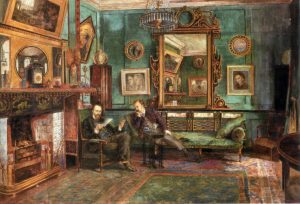Interior Design Styles: Victorian Room in the early 1900s
From Victorian to Edwardian, when we think of all interior design styles, these two come up as among the most important decoration styles in history.
What is the Victorian-style interior design?
The Victorian era – the period between 1837 and 1901 – was a time of massive industrial development and this was reflected in people’s homes and interior design styles have many new elements to reflect that decorative development.
Factories started to mass-produce items that previously only the wealthy could afford. Ornate furniture could be factory-made faster and at a lower cost than simple handmade pieces. With improved printing and weaving methods, patterned wallpapers and fabrics were used instead of paint and hand-woven furnishing fabrics.
How did Victorians decorate their homes?
Colors and patterns
The colors and patterns of this interior design style were distinctive. The Victorians were very keen on nature and this was reflected indoors. Floral patterns are used a lot, often in strong rich colors, as well as prettier pastels.
The Orient was a strong influence too – this was the height of the British Empire – and traditional interior design styles from the East are used in rugs SF laid on polished boards or over carpeting.
Windows
Windows are covered with heavy drapes, held back with tasseled tiebacks, and often combined with decorative pelmets and floor-length lace panels.
Furniture
Furniture ranges from the highly ornate to the more bulky and solid, preferably in dark woods. The original furniture is quite expensive, but good reproductions are available. The interior design styles are heavily decorated, there are plenty of knick-knacks and framed photographs in silver frames, patterned china, and leather-bound books. And, of course, plants. No Victorian home would have been complete without at least one aspidistra, a beautiful decorative plant.

Victorian decorative arts refers to the style of decorative arts during the Victorian era. Victorian design is widely viewed as having indulged in a grand excess of ornament.
What are the characteristics of Victorian interior design style?
Living and dining rooms were an intelligent mix of furniture, fabrics, and objects centered by a pretty fireplace, giving the room an authentic air. The bedrooms had strongly patterned wallpaper, which was a hallmark of the Victorian interior design style. Curtains were long and generous, matching the bed linen and bedside tables would have been covered in patterned cloths and chintz over-cloths. Bathrooms featured hand-painted Victorian tiles, ball-and-claw bathtubs, and brass fittings, while kitchens were modern and traditional, often with stained glass windows, chequered floor tiles, and fireplaces.
What is Edwardian interior design style?
From the 1880s onwards, there was a reaction against the heavy, dark, and over-furnished interiors of the previous decades. Younger Victorians – the Edwardians – started to favor simpler, interior design styles, a lighter look for their homes. Paler woods such as oak, walnut, birch, or sycamore were popular. Paintwork, too, was lighter – cream or white, green, pink or pale yellow.
A key influence on Edwardian design was William Morris, whose Arts and Crafts movement inspired a revolt against the mass-produced machine-made furniture of the earlier Victorian era. Everything from furniture to ceramics was produced by hand and so had a more individual quality.
Other influences were Ambrose Heal, whose pioneering furniture designs favored a simple construction that allowed the natural beauty of the wood to show, and Liberty, whose famous Art Nouveau prints became one of the most distinctive hallmarks of this period.
What are the most important elements of the Edwardian interior design style?
Furniture
Furniture featured curving lines and rounded fronts. Unique details include slim, high verticals on chairs and bed heads; hollows hand-holes on drawers instead of metal handles; and plenty of decorative carving on wood.
Wallpaper and fabric designs
Wallpaper and fabric designs were inspired by the country and the garden. Roses rambled everywhere, while stylized elongated tulips and irises echoed the lines of furniture.
Floors
Floors were still mainly stained wooden boards with Oriental or Persian-look rugs. Hallways are often tiled, either in chequerboard black and white patterns or in blues, browns, and beiges for more intricate designs. In many Edwardian houses, tiling beginning on the path outside and continuing along the hallway inside can still be seen. Stained glass provided a pattern for the front of the house, and windows and glass doors.
Accessories
Plates, bowls, and vases were made from embossed pewter or copper. Decorative enamels and new, experimental glazes on pottery provided a wealth of detail and interest.
The Edwardians loved a light interior design style, a delicate look of lace, and used it for everything from window panels to tablecloths, as well as to trim bed linen and covers, cushions, and lampshades. Bedrooms and bathrooms lent themselves to a more self-indulgent approach, inviting pleasure-lovers to relax in tranquil comfort, as opposed to downstairs rooms, which called for heavier and darker fabrics for practicality and due to a lack of modern cleaning methods.
Simpler lines for furniture and lighter floral designs in fabrics have the Edwardian home in an altogether airier, less cluttered feel than its immediate Victorian predecessor. Dark wood furniture was backed by paler walls to create distinct focal points within a room.
Victorian and Edwardian interior design styles are sometimes confused and considered to be almost the same, but there are subtleties that differentiate them and important decorating elements that set them apart.




